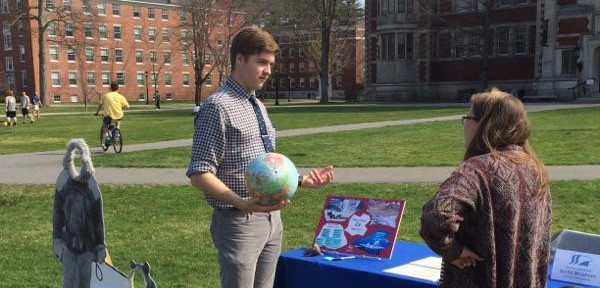Peary-MacMillan Arctic Museum

G.H. Edwards
Bowdoin College, 2014 Web
Honors’ Thesis (Bowdoin College) on the interplay between Late Holocene Arctic climate and glacial sediment delivery to a proglacial lake basin. Fieldwork (2013) conducted through the Svalbard REU program.
G.H. Edwards and T. Blackburn
Geology, 2018 PDF Web
We combine U-Pb thermochronology of rutile and apatite from middle-to-lower crustal xenoliths form an Attawapiskat kimberlite with paired crustal thermal and Pb-production diffusion models to ascertain the timescales of plume heating beneath the Superior Craton in midwestern Canada. Thermochronologic data are best fit by model simulations in which the Attawapiskat lithosphere experienced a ca. 1.1 Ga heating event triggered by partial lithosphere removal and mantle temperatures >200 °C in excess of that of ambient mantle, consistent with a model of ∼100 m.y. plume head residence beneath the Attawapiskat region.
G.H. Edwards and T. Blackburn
Science Advances, 2020 PDF Web
LL chondrite cooling histories require a ≥150-km parent body and accretion concurrent with LL chondrule formation.
T. Blackburn, G.H. Edwards, S. Tulaczyk, M. Scudder, G. Piccione, B. Hallet, N. McLean, J.C. Zachos, B. Cheney, J.T. Babbe
Nature, 2020 PDF Web
Press coverage in National Geographic
U-series isotopics of subglacial precipitates from beneath the East Antarctic Ice Sheet (EAIS) record an open-system event ca. 400,000 years ago in the subglacial Wilkes Basin. Our data and models support ice retreat and seawater incursion during this time, suggesting that the Pleistocene EAIS was not as stable as previously assumed. These findings bear important implications for future EAIS stability in a warming climate.
G.H. Edwards, T. Blackburn, G. Piccione, S.Tulaczyk, G.H. Miller, C. Sikes
Science Advances, 2022 PDF Web
Subglacial mineral precipitates record ocean forcing of Heinrich events and widespread subglacial groundwater connectivity.
G.H. Edwards, C.B. Keller, E.R. Newton, C.W. Stewart
Nature Astronomy, 2024 Web Preprint Code
We use a Bayesian statistical code to constrain the timescales of giant planet migration and asteroid belt bombardment in the early solar system. Our results associate giant planet migration with the dissipation of the gaseous protoplanetary disk.
I was invited to write a more broadly accessible Research Briefing that summarizes the relevance and main conclusions of our study.
The preprint was also summarized by Astrobites, and I was quoted in two recent articles on the topic of giant planet migration in Science Magazine and Sky & Telescope.
G.H. Edwards, G.G. Piccione, T. Blackburn, S. Tulaczyk
Chemical Geology, 2025 Web Code Data
Uranium series isotopes are sensitive tracers of both chemical and physical weathering. We report U-series data from fine-grained sediments form Taylor Valley, Antarctica that were deposited over the course of the last million years. Using novel numerical techniques we interpret the coupled chemical-physical weathering histories and show that Taylor Glacier has been eroding into Taylor Valley over the course of the Pleistocene.
A. Abuawad, M. Griffiths, G.H. Edwards, A. Eftekhari, M. El-Ebweini, H. Al-Najar, A. Butmeh, R. Abu Dayyeh, M. El-Shewy, A. Aker.
American Journal of Public Health, 2025 Web Preprint
A range of environmental and environmental health scientists weave their perspectives into a review/synthesis report on the ongoing genocide and ecocide of Israel’s military campaign in Gaza.
Teaching Assistant, UC Santa Cruz, Earth & Planetary Sciences, 2018
Introductory Earth Science coarse covering the fundamentals of geosciences, with an emphasis on solid Earth topics.
Instructor: Prof. Terrence Blackburn.
Teaching Assistant, UC Santa Cruz, Earth & Planetary Sciences, 2018
Overview of the meteorite record and the processes of solar system evolution and planetary formation from a geochemical perspective.
Instructors: Profs. Myriam Telus and Terrence Blackburn.
Teaching Assistant, UC Santa Cruz, Earth & Planetary Sciences, 2019
Field-based course focusing on fundamental geologic principles, field skills, and the creation of geologic maps.
Instructor: Dr. Hilde Schwartz
Teaching Assistant, UC Santa Cruz, Earth & Planetary Sciences, 2020
Overview of Earth system processes and history for Earth science majors.
Instructors: Profs. Paul Koch and Terrence Blackburn.
Teaching Assistant, UC Santa Cruz, Earth & Planetary Sciences, 2021
Radiogenic and stable isotope geochemistry: isotopic systems and their applications in the Earth sciences.
Instructors: Profs. Terrence Blackburn and Jim Zachos.
Lecturer (Instructor of Record), Dartmouth College, Physics & Astronomy, 2023
Introductory astronomy course covering the fundamentals of astronomy with an emphasis on the diversity of astronomical objects and how we have described them with observational techniques. (Co-instructors: Prof. Elisabeth R. Newton, Prof. Aaron L. Dotter).
Co-Instructor, Dartmouth College, Earth Sciences, 2023
Glaciology, paleoclimate, and surface mapping segment (Oct. 15–23) of a full-term field geology course. Field sites in the Eastern Sierra Nevada of California, including Long Valley, Owens Valley, and the Mono Basin. Co-instructor: Prof. Meredith Kelly)
Lecturer (Instructor of Record), Dartmouth College, Physics & Astronomy, 2024
Introductory astronomy course covering the fundamentals of astronomy and planetary science.
Professor, Trinity University, Earth & Environmental Geosciences, 2025
Introductory Earth science course with an emphasis on Earth’s systems and environmental geoscience.
Professor, Trinity University, Earth & Environmental Geosciences, 2025
Intermediate-level geomorphology.
Professor, Trinity University, Earth & Environmental Geosciences, 2025
Advanced climate science and Earth climate history.